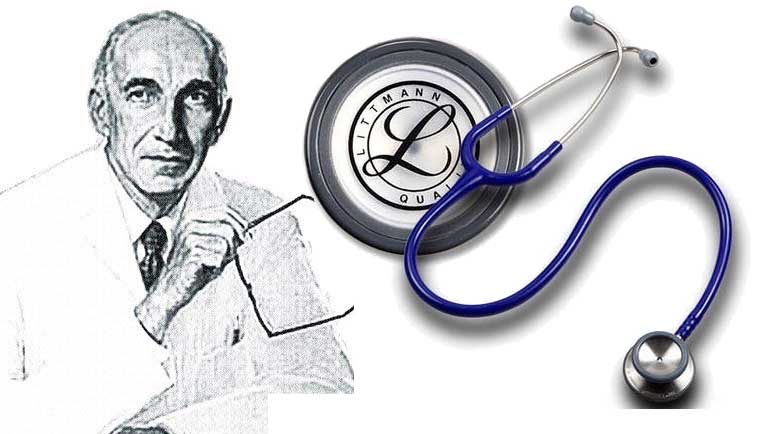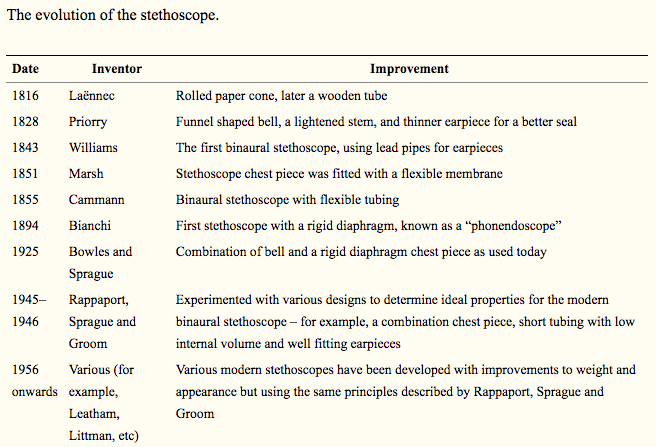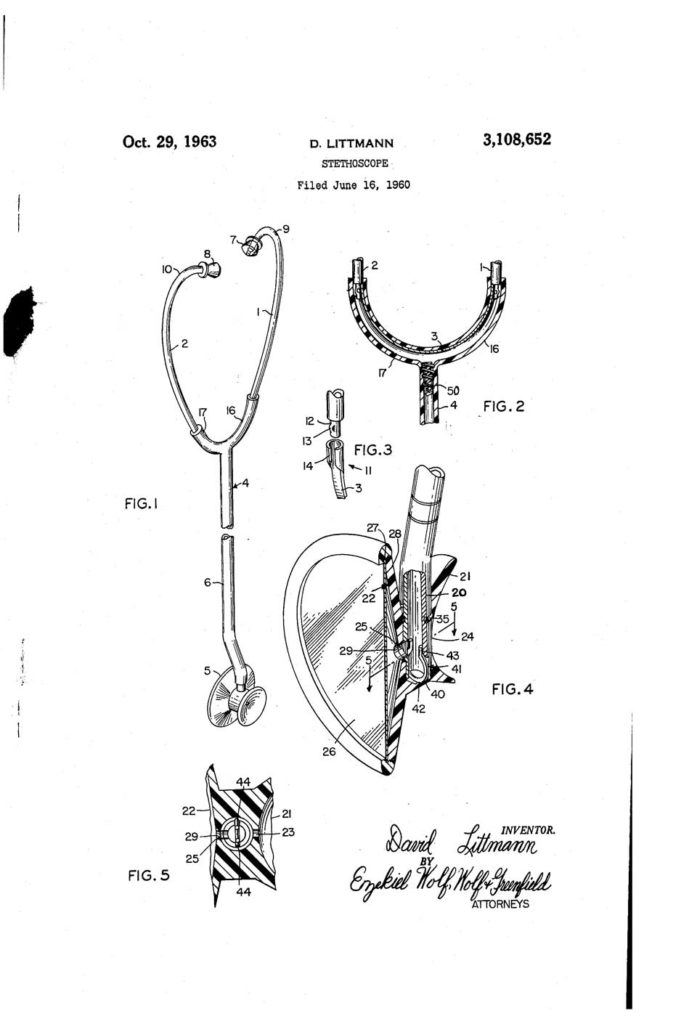Listen Carefully, Inventor

Few can argue that nothing imbues more trust and credibility into an approaching doctor than the sight of the mythical stethoscope that hangs loosely around his neck, symbolizing 257 years of medical evolution including some important patents along the way.
While historians will mark 1761 as a key year in which the value of chest percussion was identified in Vienna, others will remind us of over 20 additional milestones over the last two centuries in which structural and conceptual improvements were made that to the powerful listening device.
Yet I argue there are two key defining moments in the history of the stethoscope which should intrigue medical inventors in terms of the creative process and profiting from it.
In 1816, a caring and scientific approach by a French Doctor, Rene Theophile Hyacinthe Laënnec triggered the first incantation of the modern-day stethoscope when he saw two children sending signals to one another using a long piece of solid wood and pin. The amplified sound waves produced by the listening method stuck in his memory as he went to examine a young woman who had heart disease. Decorum, sensitivity and other aspects of the situation prompted him to tightly roll up a piece of paper and use as it a listening bridge between his ear and her chest.
“I was surprised and elated to be able to hear the beating of her heart with far greater clearness than I ever had with direct application of my ear,’ said Laënnec.
His chance observation of two youngsters sending sound signals to each other via wood and pins, led to a miracle invention that would profoundly change the course of modern-day medicine. Over the years he refined his prototype, deciding that a hollow tube of wood would ultimately serve his purposes well.
A dizzying array of improvements to his original device would manifest itself over the following centuries which included the binaural, the diaphragm, and the combined bell and diaphragm (with dual or triple heads).
The U.S. National Library of Medicine would describe other modifications designed for teaching, electronic and differential (2 chest pieces) stethoscopes. These can be seen in the table below.
However, arguably the event that shaped the modern-day stethoscope as we know it belongs to a Cardiologist, Harvard Professor and Medical Doctor, David Littman, and founder of Cardiosonics, a company he created to sell his Littman Stethoscope aimed at both doctors and nurses.
Legend has it, that Littman slaved away in his self-made metal shop situated in his home basement to make the initial prototypes. Lightness, durability, portability and the pursuit of a zero-defect acoustic sound wave drove him forward to perfect his device.
This passion and dedication to the inventing process is mirrored in other inventors I have profiled on The Patent Professor including “Unlocking the Secrets of the “Cube” for Inventors” and “It Will Not Burn. It Will Not Melt.” ~ Insights Into One of the Greatest Inventors of the 20th Century.”
“AN IDEAL stethoscope should be able to deliver to the ears, without important loss or distortion, all audible physiological phenomena,” Littman would later write.
According to the intrepid Cardiologist, these sounds normally fall in the acoustic range of 60-600 cycles per second, with some unimportant components of mitral diastolic murmurs below 60 and a few pulmonary rhonchi and rales as high as 1,000 cycles.
“Popular conceptions notwithstanding, no acoustic stethoscope amplifies or increases the original sounds. The very best ones transmit them to the examiner’s ears with relatively few losses.”
His invention, unveiled towards the beginning of the 1960s, would fundamentally alter the direction of the medical field, capturing a dominant market share and attracting the eyes of larger medical companies noticeably impressed by the improvements he made on this well-known medical device.
Up and until this point, most stethoscopes currently in use were formed with a pair of rigid ear tubes interconnected by a flexible Y member.
“An external spring arrangement spring tensions the ear tubes towards one another so that they may freely grip the wearers head. This type of construction is cumbersome and bulky,” wrote Littman in his well-crafted patent application.
“Several modifications have been made to improve such structures by integrally forming the spring member with the Y-shaped interconnecting tube. Such modifications, however, have not been satisfactory for several reasons.”
After outlining further limitations pertaining to other models on the marketplace he claimed his device overcame these problems by
providing an integral stethoscope having two ear tubes interconnected by a synthetic resin flexible Y-shaped sound tube.
“The receiver of the stethoscope is formed with a dual receiver having novel means for connecting one of two microphones to the sound tube.”
In a nutshell, his improved version had a single short tube connected to a 2-sided stethoscope which bifurcated into the ear pieces, producing acoustic pressure waves that traveling to the listener’s ears
The marketplace responded favorably with the points brought up in his successful patent, noting improved acoustics and an altogether light footprint with a single tube binaural available in both stainless steel and light alloy.
Some estimate that the device captured up to 70% of overall sales by the turn of the 20th Century attracting the attention of giant conglomerate, 3M.
In 1967, 3M purchased his business operations, intent to turn the device into an even more powerful diagnostic medical tool. Dr. Littman stayed on as consultant helping to make his stethoscope the gold standard in acoustics, medical design, and performance.
Several dozen enhancements and product evolutions followed along with an increase in sales which even today remains a closely guarded secret.
However, each time a patent or trademark infringer is taken to court by the legal team, new details emerge on the runaway success of this remarkable tool.
In one such case it emerged that 3M sells “tens of thousands” of its Cardiology III and Master Cardiology scopes – two popular models – resulting in over $15 million in sales. brings to 3M.
3M have always shown high regard and esteem for Dr. Littman stating that the entrepreneur demonstrated two undeniable qualities that it typically sees in all inventors under its fold: A profound understanding of customer needs; and the ability to imagine how various technologies could be connected in novel ways, in order to solve their customers’ challenges.
Today the art of listening to sound waves through the acoustic tubes is finally being superseded by the science of electronic monitoring and Bluetooth applications which allow machine learning algorithms in the cloud to decipher the mysteries of the heart murmur and chest vibrations.
Nevertheless, the Stethoscope and its accompanying patent remain a cornerstone of modern medicine and a defining tool of doctors who profoundly influence the lives of patients and the American healthcare system.
https://www.medicaldevicepatentattorneys.com/2018/09/listen-carefully-inventor/trackback/


